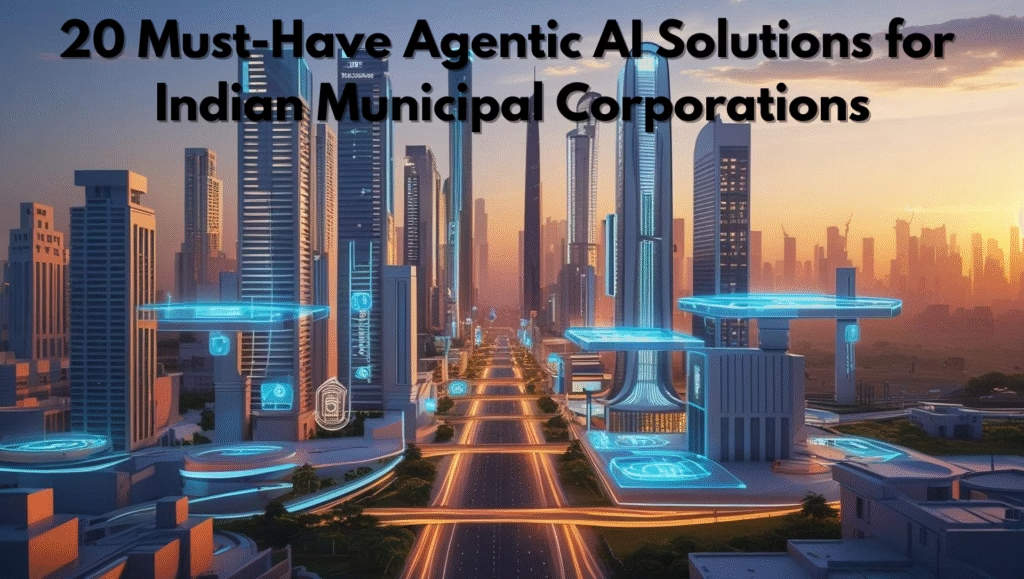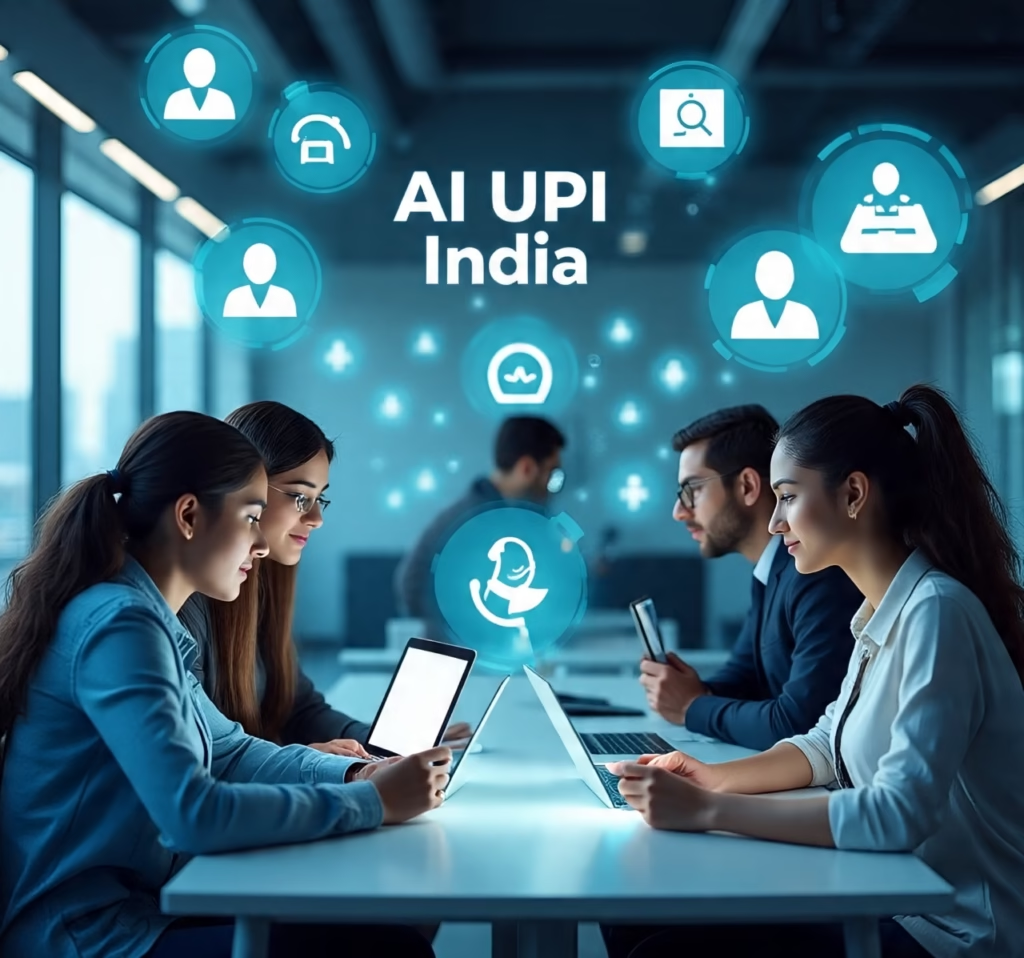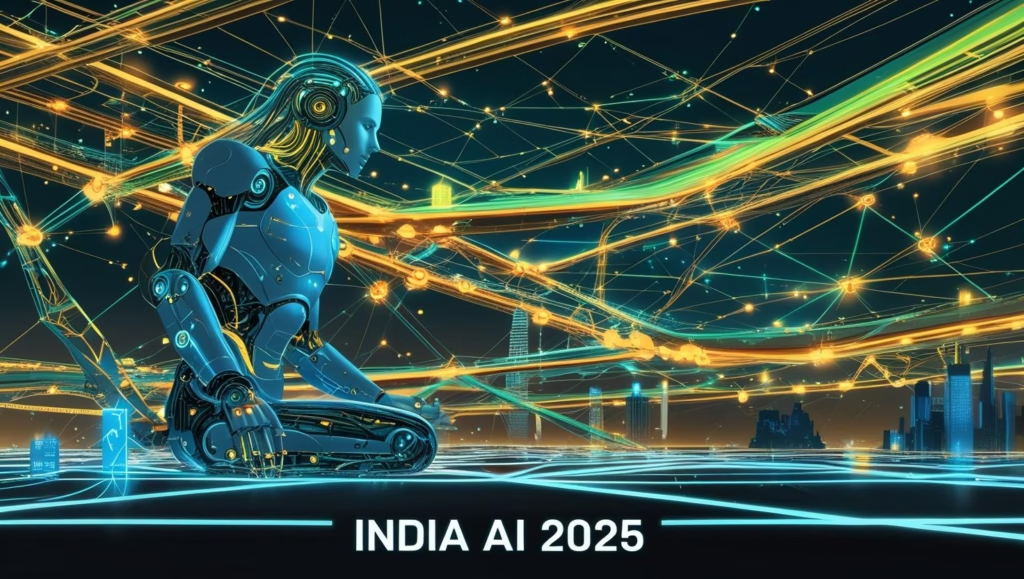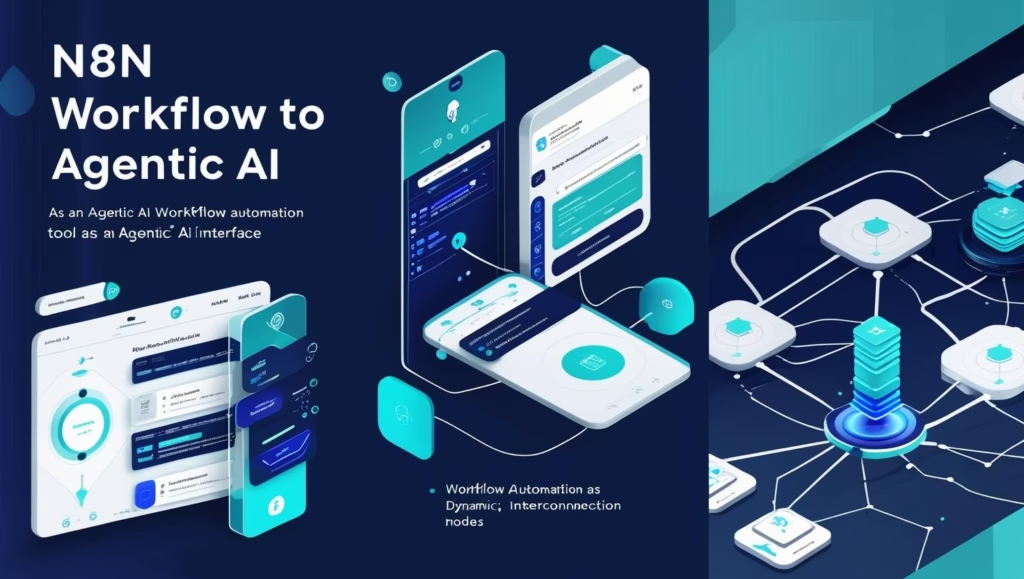Unlocking Urban Efficiency: 20 Must-Have Agentic AI Solutions for Indian Municipal Corporations
India’s megacities like Mumbai, Delhi, and Bangalore are growing faster than ever before. With rapid urbanization comes a host of challenges: traffic congestion, waste management, public health concerns, and increasing citizen expectations for efficient, transparent services. Traditional city management methods are struggling to keep pace.
This is where agentic AI intelligent, autonomous digital agents can make a real difference. Unlike simple automation, agentic AI learns, adapts, and acts proactively to optimize city operations. From managing waste routes to predicting disease outbreaks, these AI-powered solutions are transforming how cities function.
In this blog, we explore 20 cutting-edge agentic AI applications that are already making waves or showing strong promise in Indian municipal corporations. We’ll look at how they work, their current status in India, benefits, challenges, and recommend proven tools you can explore.
1. Smart Waste Management Agent
Description:
Imagine a city where garbage trucks only come when bins are full, and routes are optimized to save fuel and time. That’s exactly what smart waste management agents do.
How it Works:
IoT sensors installed in bins send real-time fill-level data to an AI system. This system schedules pickups dynamically and plans the most efficient routes for collection trucks.
Status in India:
Cities like Pune and Indore have piloted such systems, reporting up to 30% cost savings and cleaner streets.
Benefits:
- Reduced operational costs and emissions
- Improved city cleanliness
- Better citizen satisfaction
Challenges:
Deploying sensors citywide and integrating with existing fleet management systems can be complex.
Recommended Tool:
Ineffable AI WasteTrack
2. AI-Powered Citizen Grievance Redressal
Description:
Nobody likes waiting weeks for a complaint to be addressed. AI-powered grievance redressal platforms provide instant responses and streamline issue resolution.
How it Works:
Citizens submit complaints via WhatsApp, apps, or websites. AI chatbots triage and resolve common issues or escalate complex ones to officials.
Status in India:
Delhi’s “Samvaad” and Bangalore’s BBMP Sahaaya have successfully reduced resolution times.
Benefits:
- 24/7 availability
- Faster complaint resolution
- Transparent tracking for citizens
Challenges:
Ensuring multilingual support and protecting user data privacy are key.
Recommended Tool:
Yellow.ai
3. Traffic & Mobility Optimization Agent
Description:
Traffic jams are a daily headache. AI agents can ease congestion by managing signals and suggesting alternate routes in real-time.
How it Works:
Sensors and cameras feed traffic data to AI, which adjusts signal timings and informs commuters via apps or signboards.
Status in India:
Bangalore and Mumbai have piloted adaptive traffic control systems with promising results.
Benefits:
- Reduced congestion and travel times
- Lower pollution from idling vehicles
- Enhanced road safety
Challenges:
Requires extensive sensor deployment and coordination across traffic agencies.
Recommended Tool:
Siemens Mobility Sitraffic
4. Predictive Public Health Surveillance
Description:
Early detection of disease outbreaks can save lives. AI helps by analyzing diverse health data to predict and prevent epidemics.
How it Works:
Data from hospitals, pharmacies, and mobility patterns are analyzed to spot unusual trends and alert health authorities.
Status in India:
Maharashtra’s COVID-19 surveillance and Delhi’s dengue prediction pilots have shown effectiveness.
Benefits:
- Timely interventions
- Better resource allocation
- Improved public health outcomes
Challenges:
Data sharing and privacy concerns require careful handling.
Recommended Tool:
IBM Watson Health
5. Automated Building Permit & Compliance Agent
Description:
Lengthy permit approvals frustrate builders and citizens alike. AI can speed up approvals while ensuring compliance.
How it Works:
Applicants submit plans online; AI checks them against regulations and blockchain ensures transparency.
Status in India:
Hyderabad and Pune have piloted such systems with reduced approval times.
Benefits:
- Faster, transparent approvals
- Reduced corruption
- Higher compliance rates
Challenges:
Legacy system integration and staff training are essential.
Recommended Tool:
AutoDCR by SoftTech Engineers
6. Smart Utility Management Agent
Description:
Balancing supply and demand for water, electricity, and gas is tricky. AI optimizes this balance in real-time.
How it Works:
Sensors monitor consumption; AI predicts demand spikes and adjusts supply accordingly.
Status in India:
Bangalore’s BWSSB and Delhi’s BSES have piloted smart utility management.
Benefits:
- Reduced wastage
- Cost savings
- Improved reliability
Challenges:
Requires IoT infrastructure and cybersecurity measures.
Recommended Tool:
Honeywell Smart Utilities
7. AI-Driven Public Safety & Surveillance
Description:
AI enhances public safety by detecting suspicious activity and enabling faster emergency responses.
How it Works:
Real-time video feeds are analyzed for anomalies; facial recognition helps identify suspects.
Status in India:
Delhi and Mumbai police use AI-enhanced surveillance for crime prevention.
Benefits:
- Safer streets
- Quicker emergency responses
- Data-driven policing
Challenges:
Privacy, bias, and public trust are critical concerns.
Recommended Tool:
Staqu JARVIS
8. Citizen Engagement & Participatory Governance Agent
Description:
AI platforms make it easier for citizens to participate in governance through surveys and consultations.
How it Works:
Virtual agents collect and analyze citizen feedback, helping officials make informed decisions.
Status in India:
Bangalore’s “MyCityMyBudget” and Mumbai’s participatory budgeting pilots show strong engagement.
Benefits:
- Inclusive policymaking
- Increased transparency
- Data-driven decisions
Challenges:
Bridging the digital divide and ensuring privacy.
Recommended Tool:
Civis.vote
9. Sustainable Urban Planning Agent
Description:
AI helps plan cities sustainably by analyzing land use, pollution, and traffic patterns.
How it Works:
GIS and environmental data are modeled to recommend development strategies.
Status in India:
Delhi and Pune have piloted AI-driven urban planning tools.
Benefits:
- Greener cities
- Efficient land use
- Reduced pollution
Challenges:
Requires quality spatial data and inter-agency collaboration.
Recommended Tool:
ESRI ArcGIS Urban
10. No-Code AI Development Platforms for Municipal Staff
Description:
Non-technical municipal staff can build AI apps to solve local challenges without coding.
How it Works:
Drag-and-drop platforms enable rapid AI workflow creation.
Status in India:
Pilots in Chennai and Pune empower staff to innovate.
Benefits:
- Faster innovation
- Reduced IT dependency
- Tailored solutions
Challenges:
Training and data security are key.
Recommended Tool:
Quixy
11. Dynamic Energy Grid Management Agent
Description:
AI balances energy supply and demand, integrating renewables and minimizing outages.
How it Works:
Real-time consumption and weather data help AI optimize grid operations.
Status in India:
Delhi and Bangalore pilots with Tata Power and BESCOM.
Benefits:
- Fewer blackouts
- Efficient renewable integration
- Cost savings
Challenges:
Requires smart meters and IoT infrastructure.
Recommended Tool:
Siemens Spectrum Power AI
12. AI-Driven Water Leak Detection Agent
Description:
AI detects leaks in water pipelines, enabling quick repairs and reducing losses.
How it Works:
Sensors monitor pressure and flow; AI pinpoints leaks for timely action.
Status in India:
Hyderabad and Nagpur have piloted this technology.
Benefits:
- Water savings
- Infrastructure protection
- Cost reduction
Challenges:
Sensor deployment and response speed are vital.
Recommended Tool:
Aquarius Spectrum Leak Detection
13. Autonomous Street Lighting Management
Description:
AI adjusts streetlight brightness based on activity and conditions to save energy.
How it Works:
Motion and ambient light sensors feed AI to dim or brighten lights as needed.
Status in India:
Pune and Surat have implemented smart lighting pilots.
Benefits:
- Energy savings
- Enhanced safety
- Lower emissions
Challenges:
Requires sensor infrastructure and grid integration.
Recommended Tool:
Schneider Electric EcoStruxure Lighting
14. AI-Based Disaster Response Orchestrator
Description:
AI coordinates emergency services and resources during disasters for faster response.
How it Works:
Combines weather, social, and sensor data to predict disasters and optimize resource deployment.
Status in India:
Pilots in Chennai and Assam for flood and cyclone management.
Benefits:
- Saves lives and property
- Data-driven resource allocation
- Improved preparedness
Challenges:
Requires real-time data and inter-agency coordination.
Recommended Tool:
Google AI Disaster Response
15. Automated Urban Green Cover Monitoring
Description:
AI analyzes satellite and drone imagery to monitor tree cover and detect illegal encroachments.
How it Works:
Image recognition identifies changes and alerts authorities.
Status in India:
Used by BBMP (Bangalore) and NDMC (Delhi).
Benefits:
- Protects green spaces
- Supports climate goals
- Enables enforcement
Challenges:
Requires high-quality imagery and agency collaboration.
Recommended Tool:
ESRI ArcGIS AI
16. AI-Enabled Urban Noise Monitoring
Description:
AI monitors noise pollution, identifies sources, and helps enforce regulations.
How it Works:
Distributed sensors and AI map noise hotspots for targeted action.
Status in India:
Pilots in Mumbai and Hyderabad.
Benefits:
- Improves public health
- Supports enforcement
- Data-driven planning
Challenges:
Sensor deployment and regulatory coordination.
Recommended Tool:
Acoem Noise Sentinel
17. AI-Driven Public Transport Scheduling
Description:
AI optimizes public transport schedules based on real-time demand and traffic.
How it Works:
Analyzes commuter data to dynamically adjust routes and timings.
Status in India:
Delhi Transport Corporation and BMTC (Bangalore) pilots.
Benefits:
- Reduced wait times
- Increased ridership
- Cost savings
Challenges:
Integration with ticketing and GPS systems.
Recommended Tool:
Optibus AI Scheduling
18. AI-Enhanced E-Governance Document Processing
Description:
AI automates processing of permits, licenses, and certificates, reducing manual workload.
How it Works:
Scans documents, extracts data, flags inconsistencies, and routes approvals.
Status in India:
Pilots in Mumbai and Delhi.
Benefits:
- Faster approvals
- Fewer errors
- Transparent processes
Challenges:
Digitization and secure data handling.
Recommended Tool:
DocuSign Intelligent Agreement Cloud
19. AI-Powered Urban Air Quality Management
Description:
AI monitors and predicts air quality, recommends interventions, and informs citizens.
How it Works:
Analyzes sensor and satellite data to trigger alerts and suggest measures.
Status in India:
Deployed in Delhi and Bangalore.
Benefits:
- Protects public health
- Enables targeted action
- Real-time alerts
Challenges:
Requires dense sensor networks and coordination.
Recommended Tool:
BreezoMeter AI
20. AI-Based Urban Revenue Optimization Agent
Description:
AI analyzes municipal revenue streams, identifies leakages, and optimizes collections.
How it Works:
Examines transaction data, flags anomalies, and suggests policy adjustments.
Status in India:
Pilots in Pune and Surat.
Benefits:
- Increased revenue
- Reduced fraud
- Data-driven financial planning
Challenges:
Access to financial data and ERP integration.
Recommended Tool:
SAP AI Revenue Management
Final Thoughts
Agentic AI is no longer a futuristic concept it’s here, reshaping how Indian cities operate. These 20 applications highlight how technology can solve real urban problems, from waste management to disaster response, citizen engagement to revenue optimization.
For municipal leaders, the path forward is clear: invest in data infrastructure, pilot thoughtfully, scale what works, and always keep citizens at the heart of innovation. The challenges of integration, privacy, and workforce readiness are real but surmountable with the right partnerships and governance.
Together, India’s megacities can leapfrog legacy hurdles and become global exemplars of smart, sustainable, and inclusive urban governance.
Further Reading & Resources
- Capgemini’s AI in Public Sector Report
- Deloitte Smart Cities Insights
- IndiaAI – Government AI Initiatives
- IBM Watson Health Case Studies
- ESRI Smart City Solutions
Keywords: agentic AI for Indian cities, AI in municipal governance India, smart city agentic applications, AI automation for urban India, AI-powered municipal solutions, AI for public sector India, smart waste management India, AI traffic optimization India, predictive public health AI India, AI grievance redressal India, AI-enabled urban planning, AI for utility management India, AI public safety solutions, citizen engagement AI India, no-code AI platforms India, AI disaster response India, AI urban air quality monitoring, AI revenue optimization India, smart city AI tools India, AI-enabled smart infrastructure, AI in Indian megacities, AI for sustainable urban development, AI in Indian public services, AI-powered city management, AI for smart governance India, AI in urban mobility India, AI for environmental monitoring India, AI in e-governance India, AI for citizen services India, AI-driven urban innovation India
Disclaimer: Transparency is important to us! This blog post was generated with the help of an AI writing tool. Our team has carefully reviewed and fact-checked the content to ensure it meets our standards for accuracy and helpfulness. We believe in the power of AI to enhance content creation, but human oversight is essential.





